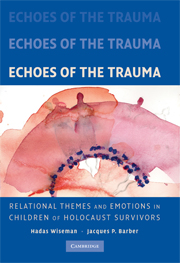Book contents
- Frontmatter
- Contents
- Foreword by Dan Bar-On
- Preface
- Acknowledgments
- 1 Introduction – A Narrative Approach to Bridging the Gap between Clinical Case Studies and Empirical Research on Children of Holocaust Survivors
- 2 Studying Relationship Narratives with the Core Conflictual Relationship Theme Method
- PART ONE RELATIONAL THEMES IN THE NARRATIVES
- 3 Wishes for Closeness and Autonomy
- 4 The Need to Protect Vulnerable Parents and to Avoid Conflicts
- 5 “Without Words”: Themes of Interpersonal Communication
- PART TWO EMOTIONS IN THE NARRATIVES
- PART THREE HEALING TRAUMA IN THE CHAIN OF THE GENERATIONS
- Appendix
- References
- Index
3 - Wishes for Closeness and Autonomy
Published online by Cambridge University Press: 29 July 2009
- Frontmatter
- Contents
- Foreword by Dan Bar-On
- Preface
- Acknowledgments
- 1 Introduction – A Narrative Approach to Bridging the Gap between Clinical Case Studies and Empirical Research on Children of Holocaust Survivors
- 2 Studying Relationship Narratives with the Core Conflictual Relationship Theme Method
- PART ONE RELATIONAL THEMES IN THE NARRATIVES
- 3 Wishes for Closeness and Autonomy
- 4 The Need to Protect Vulnerable Parents and to Avoid Conflicts
- 5 “Without Words”: Themes of Interpersonal Communication
- PART TWO EMOTIONS IN THE NARRATIVES
- PART THREE HEALING TRAUMA IN THE CHAIN OF THE GENERATIONS
- Appendix
- References
- Index
Summary
The wish for autonomy and the wish for closeness are two central dimensions of personality development and relationships according to psychodynamic theorists and attachment theory (e.g., Blatt, 2004). Human beings have innate needs for individuation and self-definition and for establishing and maintaining relatedness with others (Bakan, 1966; Buber, 1936). In this chapter we present first the themes of closeness, care, and intimacy that were depicted in the relational narratives of the second generations about parents, spouses, and children. Second, we present the themes of autonomy and control, which often appeared in diverse forms in the relationships of the second generation with significant others, especially the survivor parents. We recount separately particular narratives in which either the wish for closeness or the wish for autonomy was distinctly identified in our analysis as the central wish even though both these themes appear in some narratives. Much has been written about the conflict between the need for relatedness and the need for autonomy, and their dialectical relation (Aron, 1996; Blatt & Blass, 1990, 1992; Safran & Muran, 2000). On an intrapsychic level, personality development entails negotiating the need for agency versus the need for relatedness (Aron, 1996; Blatt, 2004). On an interpersonal level it involves negotiating the needs of the self with the needs of the other (Safran & Muran, 2000; Safran, 2003).
- Type
- Chapter
- Information
- Echoes of the TraumaRelational Themes and Emotions in Children of Holocaust Survivors, pp. 27 - 57Publisher: Cambridge University PressPrint publication year: 2008



